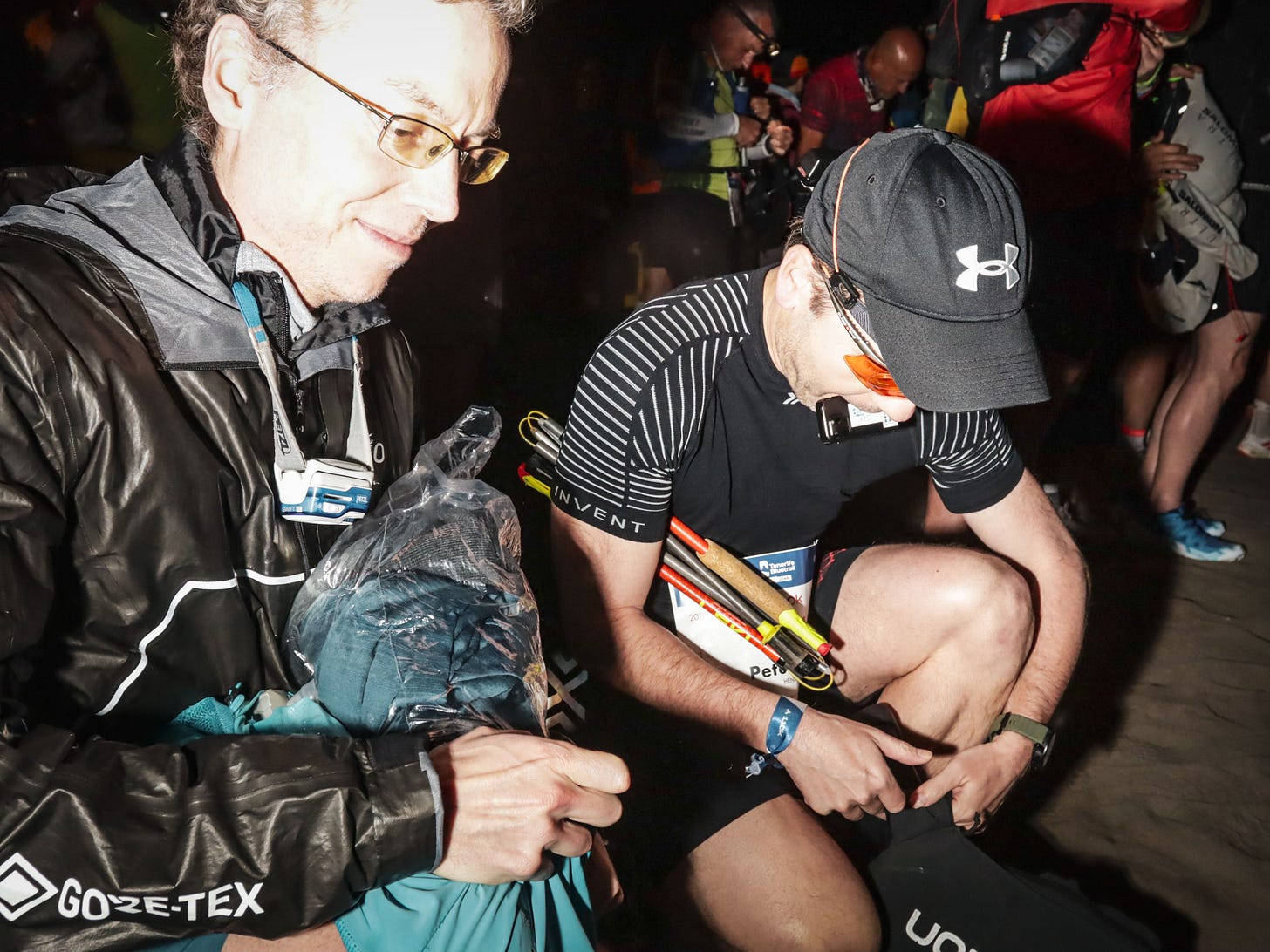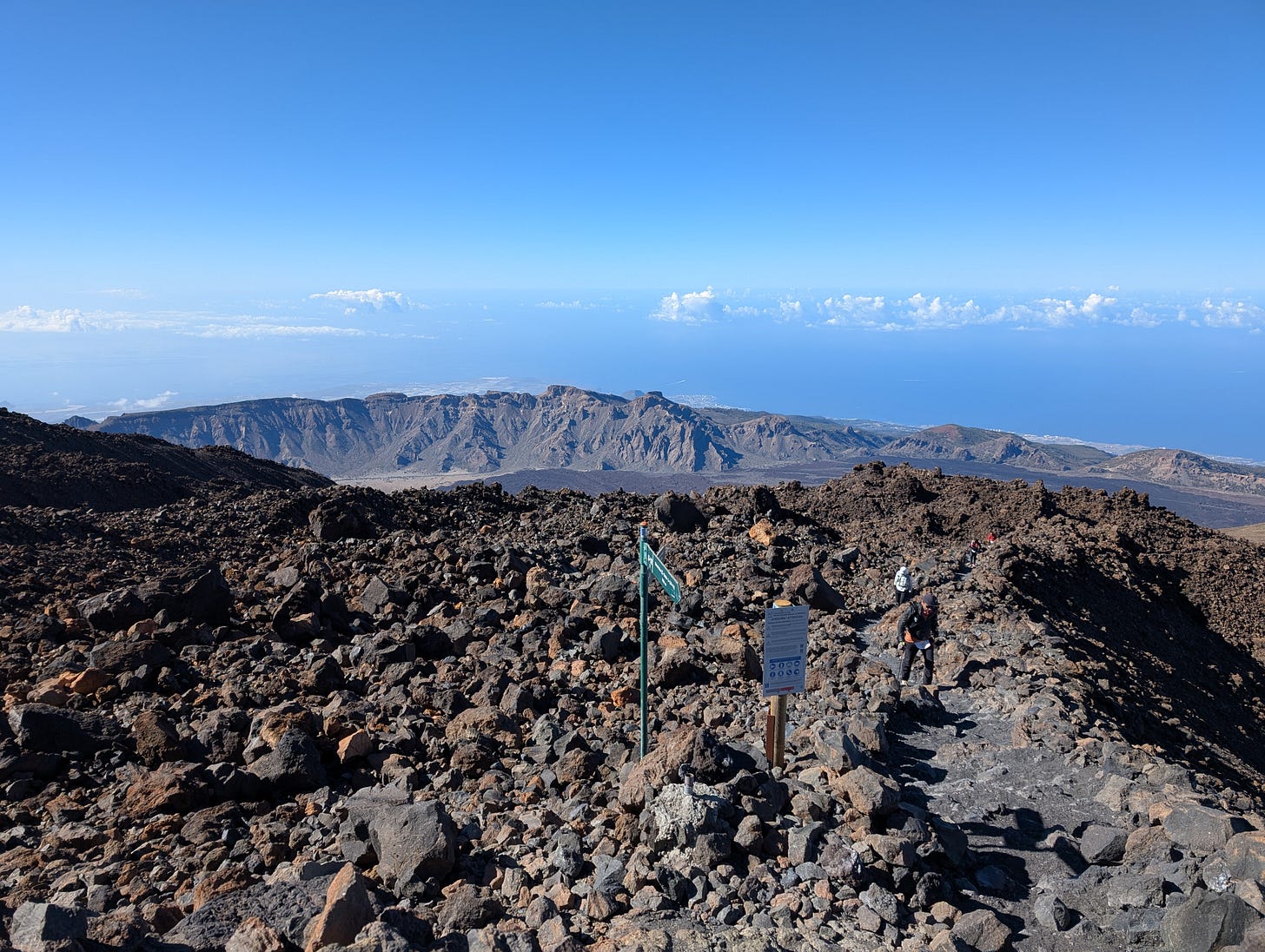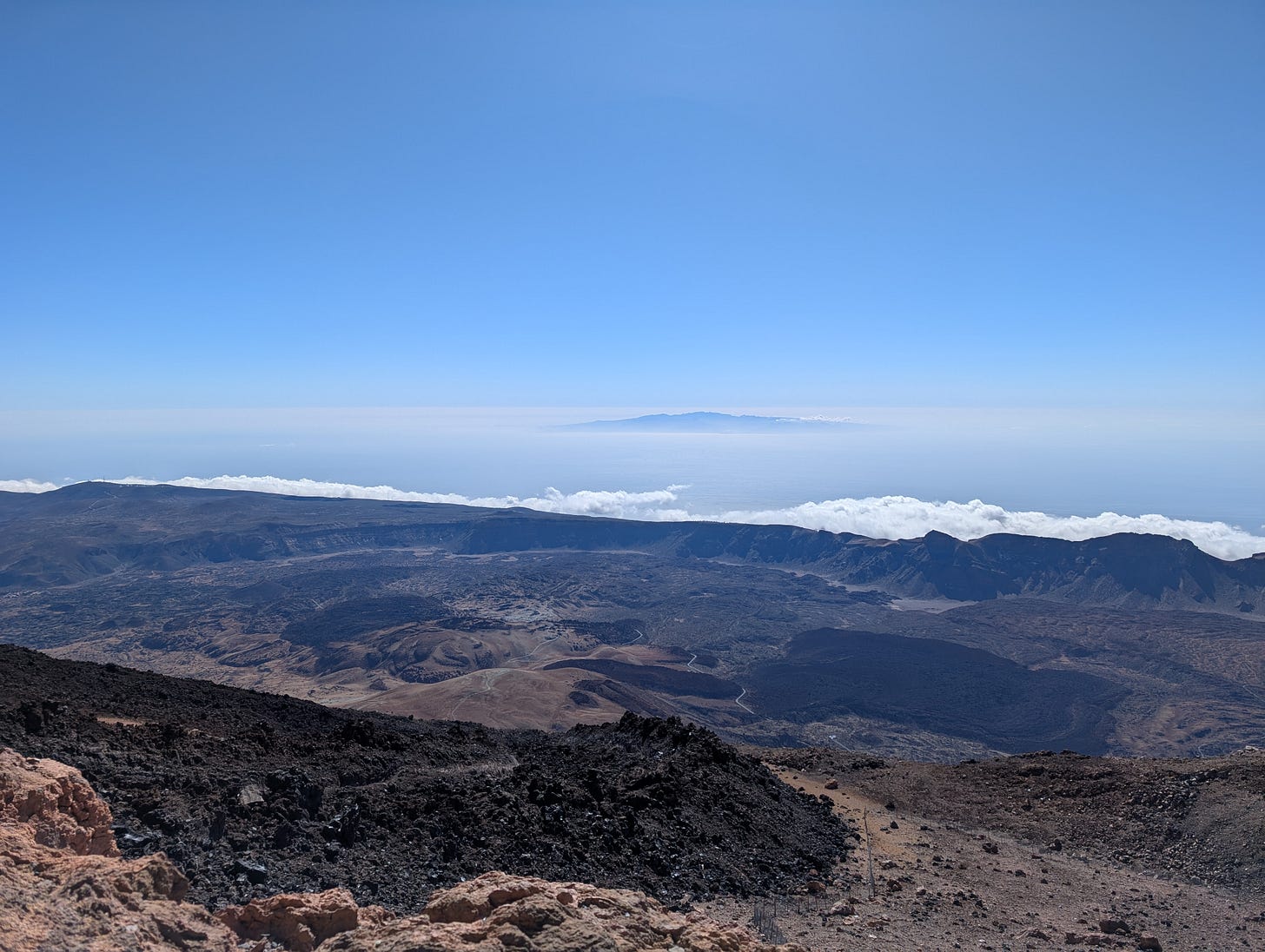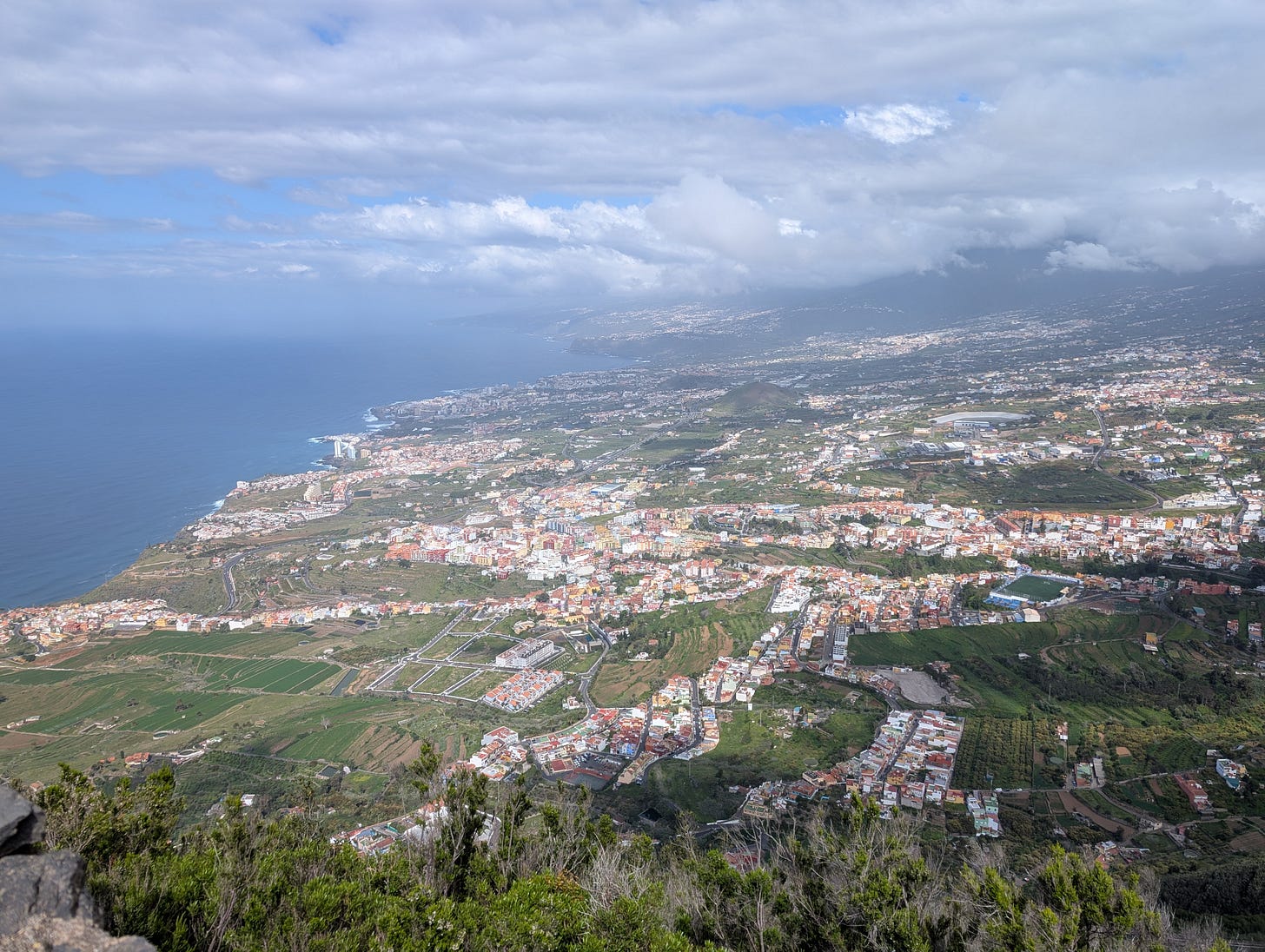This year’s race season opened with the Tenerife Bluetrail, a 110km race that leads from Los Cristianos on the Southern tip of Tenerife across Mount Teide, Spain’s highest mountain, and down again to Puerto de la Cruz on Western coast, accumulating a bit more than 6000m of climbing along the way. While I had been to Tenerife a couple of times before, including one full and two partial ascents of Teide, it was the first time racing here.
We arrived a couple of days earlier fresh out of the Bavarian late winter, and I tried to do a fast acclimatization to altitudes above 2000m and temperatures above 15°C with little success (foreshadowing). This involved several hikes on the Teide plateau, reconnoitering parts of the race course, as well as a visit to Puerto de La Cruz to run the last 4 urban kilometres before the finish line. We had decided to stay in a casa rural in La Orotava, situated only a short bus or car ride away from Puerto de la Cruz from where the shuttles to the starting line left and the race finished.
On race day, a 1.5h bus transfer took my brother and myself to the start in Los Cristianos at 11pm. Los Cristianos is a tourist hub that is more geared towards mass and beach tourism, and we were once again glad to have stayed in La Orotava just as before our second ascent of Teide in 2015. As cold weather was expected, runners were reminded that the mandatory safety equipment was indeed mandatory and would be checked, and on very short notice we had to show smartphone, safety blanket and rain jacket before being allowed to enter the starting corral on the beach. A lot of hillarity ensued, and I packed what felt like half a kg of sand when I reassembled my backpack after pulling everything out to get to the safety blanket.
Apart from a wanted person call for three of the elite women that apparently had questioned their life choices at the last minute (one of them a German runner I seem to meet at about every other race), the start went without a hitch.
We started along the promenade and the packed crowd dissipated quickly, but there was a lot of cheering from spectators in restaurants and along the walkay. We tried to keep a swift pace of about 12km/h to avoid getting stuck in traffic later on as our intel indicated that traffic jams were likely after 5km - we did not quite know why yet, though.
After running through a well cleaned concrete storm drain/the cleanest barranco I’ve ever been in, the first bottleneck made its dramating appearance - we had to scale a 20m rock face, cheered on and sometimes helped by volunteers. Fortunately, we were far enough ahead that we made it through without really breaking stride. Steady uphill running on good trails followed, and my brother said goodbye at this point to stay within his heart rate target zone which seems to be <165bpm.
I ran through the first aid station without stopping, but shortly after took a fall on an overgrown flat trail - knee, shin and ego were bruised, but while I didn't notice the scratches anymore after 30mins, it still felt annoying to crash one hour into a 18 hour race.
After that, the group I was in took the first of many wrong turns, losing the trail and then having to climb down a couple of meters through cactii back onto the trail. The going was often very slow through big boulders and dense vegetation, which was a bit surprising as I had expected mostly runnable dirt and forest roads.
After the second aid station at 19km/1200m of altitude gain in 2:30h there was some more proper climbing to be done, and some more wrong turns to be taken, but they were typically quickly corrected after about 50m. The trail markings were very hard to see and did not offer much reflection, and blindly following the guy/gal in front of you or the path of least resistance (=the fork that went downhill) was quickly punished. Finally, I not-quite bombed down a not too technical downhill into Vilaflor aid station at 33km/2250m in 4:40h.
At Vilaflor I saw one of the leading women drop out with what sounded like asthma to me and the volunteer medic looking after her. I also witnessed a poor soul haranguing the clueless food station volunteers in a language they did not speak (Heavily German-flavored English) about the availability of the Näak purees promised on the website - expecting to find any specific food or drink at a UTMB race is a bold strategy which did not turn out well for him.
Loaded up on soup and crackers which I partially spilled and dropped on the short downhill out of Vilaflor, we soon continued climbing up to Madre del Agua aid station in 40mins where runners were told to put on rain jackets due to the cold temperatures higher up. Some argued, I didn't, continued and soon started sweating profusely. Around this time I also passed a fellow runner who was already cramping out at this early stage of the race, although overheating issues seemed unlikely. Some more steep climbing with some runnable sections followed, until we finally hit the ridge of the caldera enclosing the Teide plateau. Unfortunately it was too early for sun rise or even dawn, so there were no impressive vistas to be had other than the lights from towns towards the coastline.
While dropping down into the Teide plain I had some false recognitions of the 2km I had scouted some days before, but finally entered known territory and cruised into Parador Aid station, 59km/3470m and 7:30h in, in 50th position. Parador turned out to be one of my least efficient stops ever - I first dropped my backback, went to the toilet, realized there's no toilet paper, hence went back to my backpack to retrieve tissues, etc. Then I did a full kit change and packed a lot of gels and particularly drink mix I ultimately wasn't going to use. I was out of the aid station after a bit more than 30mins. We were told to put on rain trousers due to the cold, but the only effect was more sweating and a couple of holes as high-tech fibers and volcanic rocks don't play nice with each other. Teide had turned red briefly, but then sunrise was over - Parador is probably the worst place of the entire course to be at for the sunrise.
Out of Parador there were one or two km of running, and then a lot of climbing. I had switched from Hoka Speedgoats to Mafate Speed at the aid station due to some random Reddit post discussing the merits of both shoes at different points in races, and at first this felt like I had put bricks under my feet, but I got used to it fairly quickly. I didn't tie the laces fast enough, though, which turned out to be a big problem on the terrain to come where I twisted my ankles basically with every step, but was too stubborn or oxygen deprived to take remedial action. The climb first took us up 1000m to a plateau near the old crater, and then another 500m up to Teide cable car station.
I got passed quite a few times and was feeling pretty miserable - I had no problem with the cold unlike other runners, but I felt dizzy when looking around and ran out of breath after three moderately fast steps. Acclimatization apparently failed big time, and above 2500m my personal death zone still starts as I had already discovered some years before at the Stubai Ultra Trail.
After what felt like ages and were actually precisely 3 hours, I reached the aid station at the cable car station, about 200m below the proper peak. Many were glad that we didn't have to go over there, but had reached the highest point after 61km, 4900m and 11h.
I managed to grab a chair in the crowded, small improvised aid station to put on my trusty knee bandage and look after my feet. There was little space, and hence I had another very inefficient stop taking 30mins, especially as I tried to eat some soup and bread simultaneously. The atmosphere was tense; the woman on my left was having a mental breakdown in Spanish until being calmed down by a volunteer after 5mins (lack of oxygen?), and the guy to my right couldn't stop shivering, and actually turned back soon after leaving the station. At least I was acclimatized to low temperatures and could function normally if slowly in thin air.
I then started on the pretty rocky downhill of about 1500m, with lots of hikers going in the other direction. I removed the rain trouser at the Montana Blanca plateau after asking a spectator I mistook for a race official whether it was OK to take them off now - he must have been pretty bewildered about my gestures of dropping my pants. A runnable downhill track downhill followed, and I prevented a fellow runner from taking a wrong turn - he was already 50m along the wrong trail and didn't want to believe me that he was wrong until I picked up a big rock with a race course marking and waved it over my head. Call me the Mother Theresa of ultrarunning.
We then ran through the high desert I've been in quite a few times now and then into Portillo aid station - I had lost 22 places since Parador at the start of the climb up Teide but was starting to feel better as we got lower. Portillo is still at 2200m of altitude, though, so 400m above the highest Upper Bavarian peaks. I almost ended my race at Portillo when I stepped on a loose wall stone that tumbled down and took me along, only to take my the next fall 200m later, again on a flat section and for no good reason whatsoever. This time I fell on the left knee which was protected by the bandage, so there was a lot of cursing and a forced smile and thumbs up for a concerned spectator but no real harm. I blamed my Hoka clown shoes, but it turned out that further down on technical terrain that was similar to the terrain I train on I had no footing issues whatsoever.
Motivation was running a bit low at this point as I had fallen behind my 18h time table a bit, and the trail through the forest was well runnable but boring with no sights or visible markers of progress. It got worse after the next aid station as we entered the perennial cloud cover below Teide plateau on western side of the island, visibility got worse and progress had to be hard fought for through steep dry and rocky creek beds. I was amidst the slower runners of the shorter distances by now which was just as well, as I at least had to keep running while I was being watched. However, this was also a big liability as I was running fairly quickly, and many short distance runners are not particularly mountain-worthy.
I passed a woman that stepped to the valley side of the trail to let me pass, but lost her balance (I swear I did not touch her!) and tumbled down a meter into some brambles. I helped her get out, lamented my lack of any sticking plasters, and then moved on when a traffic jam was forming behind us. She seemed to be not too pissed and not too happy about my compassion.
Finally, we arrived at Base del Asomadero, an aid station before the last big climb of about 600m in 2km. So far we had covered 92km and 5300m of climbing in 15:30h. I had mysteriously moved up again to 60th place. I took some cola and filled up my bottles, wondering why on earth I had brought so much Maurten drink mix. In the end I could have prepared about 3L more than I actually used.
At this point it didn't look like I would be able to make it to the finish line in 2.30h to hit my 18h goal with 18km and 1000m of climbing to go. I was feeling pretty energized to be climbing again and made short work of the climb, though, and the following descent was also ok - a steep mud track that must have been a nightmare for runners coming much later, but that was still manageable when I went through. I passed a mirador we had seen in the distance from our finca, then dropped down onto a tarmac road for a km and then finally down into Tigaiga, the last real aid station at 99km, 16:55h in.
I had passed another 5 runners in my race since Base del Asomadero - I later checked and found my time from Base del Asomadero to the finish about top twenty worthy. Now I only need to keep this pace for 15h straight.
There was then some more downhill down to the coastline that was surprisingly not super painful as the knee troubles I had at MIUT during the last 25km the previous year didn't make a comeback. Bandages and stretching exercises really seem to help.
We followed a surprisingly pretty trail along the coastline before we reached Hotel Maritim which put me back on known terrain as I had scouted as far from the finish line a couple of days before. To my surprise, the course was actually a bit shorter than the announced 110km, so I had 17 minutes left for the last 4km to the finish line for a sub-18h finish.
This definitely wasn't going to work, but I still gave it a fair shake with an average of 12km/h for the last 4km. Back in town there was a lot of cheering going on and I wanted to give the spectators their money's worth (no, you don't have to actually pay to watch a trail race that finishes in the middle of a city).
I was still passing quite a few runners which I all took for participatns in the shorter distance races. But about 100m before the finish line I passed a French guy who looked at my bib and then initiated an actual race to the finish as he was in the 110k distance as well.
We entered a sprint to the great amusement of the announcer and the crowds which I lost by a couple of centimetres - however, given that ultra distance timing likely doesn't have milliseconds we were ranked tied for 53th place, in 18:02h. This also gave me my best finisher photo and video ever.
Overall, the Bluetrail is a great race that goes through very different terrain and vegetation zones - from the lush coastal plain up to a rocky desert and Spain's highest mountain, then down through misty forests to the beach again. The trails were often unexpectedly brutal, and altitude continues to be my nemesis, but I still managed to enjoy fair bits of the race. We also got fairly lucky with the weather as a heavy storm hit the island just half a week later, dropping snow on Teide and cancelling all outdoor events.
My brother’s race video:






















